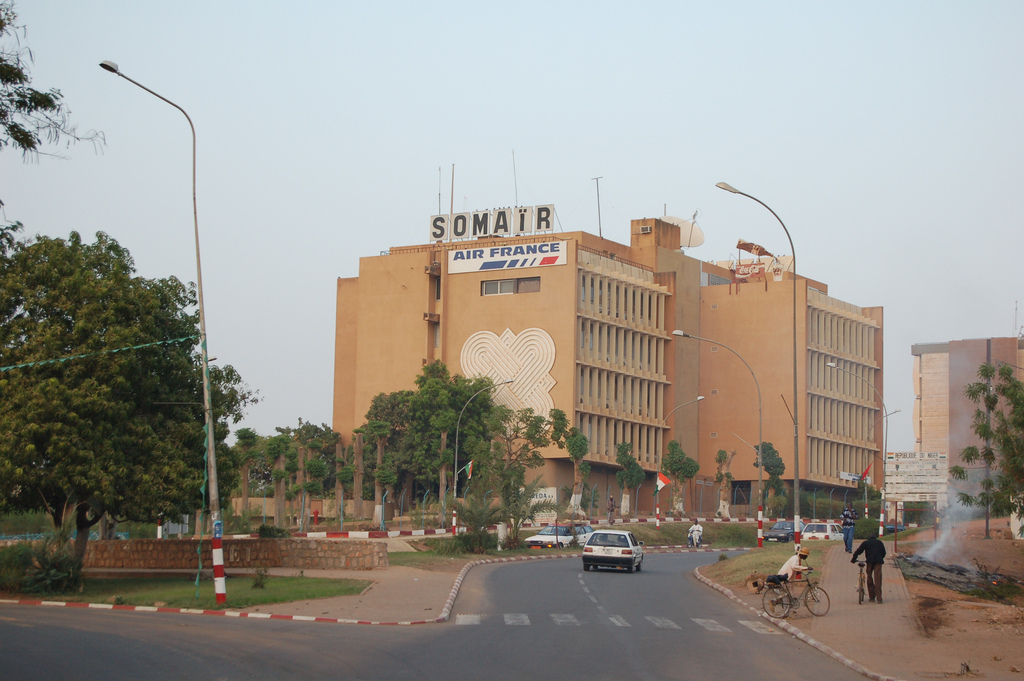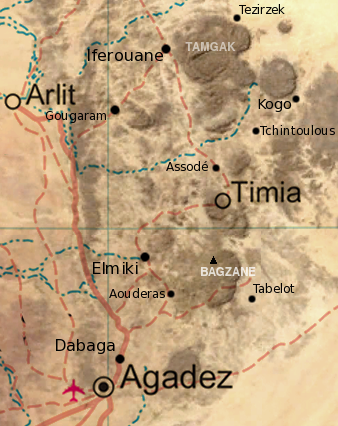|
Somair
SOMAIR (Société des Mines de l'Air) is a national mining company of Niger in the mining area of its northern zone. Established in 1968, it started uranium mining at the Arlit deposit in 1971, mining 0.30 - 0.35% ore down to depth of depth. By 1981, the company was producing 2100 tU/yr and by 2006 it was producing 1565 tU at the Tamou deposit. The production peaked to 3065 tU in 2012. The resources, according to the Red Book, are assessed at 23,170 tU, as of 2010, at 42,200 tU of 0.25%U grade recoverable conventionally, and 5500 tU of 0.07%U grade from heap leaching. SOMAIR is one of two national mining companies in Niger, the other being COMINAK in the nearby Akokan. Geography Arlit and Akokan are the twin mining towns of SOMAIR. They are situated on the southern border of the Sahara desert, where uranium is extracted, and are on the western fringe of the Aïr Mountains. They are located to the north-east of Niamey, the capital of Niger. History Discovery of uranium in ... [...More Info...] [...Related Items...] OR: [Wikipedia] [Google] [Baidu] |
Somair Building Niamey 2006
SOMAIR (Société des Mines de l'Air) is a national mining company of Niger in the mining area of its northern zone. Established in 1968, it started uranium mining at the Arlit deposit in 1971, mining 0.30 - 0.35% ore down to depth of depth. By 1981, the company was producing 2100 tU/yr and by 2006 it was producing 1565 tU at the Tamou deposit. The production peaked to 3065 tU in 2012. The resources, according to the Red Book, are assessed at 23,170 tU, as of 2010, at 42,200 tU of 0.25%U grade recoverable conventionally, and 5500 tU of 0.07%U grade from heap leaching. SOMAIR is one of two national mining companies in Niger, the other being COMINAK in the nearby Akokan. Geography Arlit and Akokan are the twin mining towns of SOMAIR. They are situated on the southern border of the Sahara desert, where uranium is extracted, and are on the western fringe of the Aïr Mountains. They are located to the north-east of Niamey, the capital of Niger. History Discovery of uranium in ... [...More Info...] [...Related Items...] OR: [Wikipedia] [Google] [Baidu] |
Arlit
Arlit is an industrial town and capital of the Arlit Department of the Agadez Region of northern-central Niger, built between the Sahara Desert and the eastern edge of the Aïr Mountains. It is 200 km south by road from the border with Algeria. As of 2011, the commune had a total population of 112,432 people. Uranium industry Founded in 1969 following the discovery of uranium, it has grown around the mining industry, developed by the French government. Two large uranium mines, at Arlit and nearby Akouta, are exploited by open top strip mining. One open pit mine was built in 1971 by the National Mining Company of Niger, SOMAIR. The Second open pit mine, as well as a third underground mine, was built by the French Compagnie Minière d'Akouta (or COMINAK). All the ore from both is now processed and transported by a French company Orano Cycle, a holding of the Orano group, itself a state owned operation of the French ''Commissariat à l'énergie atomique'' (CEA). The syst ... [...More Info...] [...Related Items...] OR: [Wikipedia] [Google] [Baidu] |
COMINAK
COMINAK (Compagnie minière d'Akokan) is a national uranium mining company of Niger. It is a joint venture between the French company Areva NC and the state of Niger, which operates in the field of mining. COMINAK was established in 1974, following a memorandum of understanding between France, Japan and Niger. They commenced uranium production in 1978, and reached a record production in 1981 with 2,260 tons of uranium. COMINAK's plant is installed in Akokan, not far from the town of Arlit. COMINAK is one of two national mining companies in Niger, the other being SOMAIR in the nearby Akokan. The U3O8 ore grade at Somaïr is 14,000 tons at 0.3%, Cominak is 29,000 t at 0.4% and Imouraren 120,000t at 0.15%. History The earliest reported exploration for uranium started in 1956 was initially by the French Atomic Energy Commission (CEA) which was continued by COGEMA. This was followed by extraction of the mines at Akouta and Akola by COMINAK. In 1970, France-Japan-Niger resea ... [...More Info...] [...Related Items...] OR: [Wikipedia] [Google] [Baidu] |
List Of Countries By Uranium Production
This contains lists of countries by uranium production. The first two lists are compiled by the World Nuclear Association, and measures uranium production by tonnes mined. The last list is compiled by TradeTech, a consulting company which specializes in the nuclear fuel market. World Nuclear Association (2021) World Nuclear Association (2018) TradeTech (2011) See also *List of countries by uranium reserves *Uranium mining by country *List of uranium projects Uranium production is carried out in about 13 countries around the world, in 2017 producing a cumulative total of 59,462 tonnes of uranium (tU). The international producers were Kazakhstan (39%), Canada (22%), Australia (10%), Namibia (7.1%), Nig ... References {{DEFAULTSORT:Uranium production Lists of countries by mineral production Production by country ... [...More Info...] [...Related Items...] OR: [Wikipedia] [Google] [Baidu] |
High-density Polyethylene
High-density polyethylene (HDPE) or polyethylene high-density (PEHD) is a thermoplastic polymer produced from the monomer ethylene. It is sometimes called "alkathene" or "polythene" when used for HDPE pipes. With a high strength-to-density ratio, HDPE is used in the production of plastic bottles, corrosion-resistant piping, geomembranes and plastic lumber. HDPE is commonly recycled, and has the number "2" as its resin identification code. In 2007, the global HDPE market reached a volume of more than 30 million tons. Properties HDPE is known for its high strength-to-density ratio. The density of HDPE ranges from 930 to 970 kg/m3. The standard method to test plastic density is ISO 1183 part 2 (gradient columns), alternatively ISO 1183 part 1MVS2PRO density analyzer. Although the density of HDPE is only marginally higher than that of low-density polyethylene, HDPE has little branching, giving it stronger intermolecular forces and tensile strength (38 MPa versus 21 MPa) than ... [...More Info...] [...Related Items...] OR: [Wikipedia] [Google] [Baidu] |
Clay
Clay is a type of fine-grained natural soil material containing clay minerals (hydrous aluminium phyllosilicates, e.g. kaolin, Al2 Si2 O5( OH)4). Clays develop plasticity when wet, due to a molecular film of water surrounding the clay particles, but become hard, brittle and non–plastic upon drying or firing. Most pure clay minerals are white or light-coloured, but natural clays show a variety of colours from impurities, such as a reddish or brownish colour from small amounts of iron oxide. Clay is the oldest known ceramic material. Prehistoric humans discovered the useful properties of clay and used it for making pottery. Some of the earliest pottery shards have been dated to around 14,000 BC, and clay tablets were the first known writing medium. Clay is used in many modern industrial processes, such as paper making, cement production, and chemical filtering. Between one-half and two-thirds of the world's population live or work in buildings made with clay, often ... [...More Info...] [...Related Items...] OR: [Wikipedia] [Google] [Baidu] |
ISO 14001
ISO 14000 is a family of standards related to environmental management that exists to help organizations (a) minimize how their operations (processes, etc.) negatively affect the environment (i.e. cause adverse changes to air, water, or land); (b) comply with applicable laws, regulations, and other environmentally oriented requirements; and (c) continually improve in the above. ISO 14000 is similar to ISO 9000 quality management in that both pertain to the process of how a product is produced, rather than to the product itself. As with ISO 9001, certification is performed by third-party organizations rather than being awarded by ISO directly. The ISO 19011 and ISO 17021 audit standards apply when audits are being performed. The requirements of ISO 14001 are an integral part of the European Union's Eco-Management and Audit Scheme (EMAS). EMAS's structure and material are more demanding, mainly concerning performance improvement, legal compliance, and reporting duties. The curr ... [...More Info...] [...Related Items...] OR: [Wikipedia] [Google] [Baidu] |
Areva
Areva S.A. is a French multinational group specializing in nuclear power headquartered in Courbevoie, France. Before its 2016 corporate restructuring, Areva was majority-owned by the French state through the French Alternative Energies and Atomic Energy Commission (54.37%), Banque publique d'investissement (3.32%), and Agence des participations de l'État (28.83%). Électricité de France, of which the French government has a majority ownership stake, owned 2.24%; Kuwait Investment Authority owned 4.82% as the second largest shareholder after the French state. As a part of the restructuring program following its insolvency, Areva sold out or discontinued its renewable energy businesses, sold its reactors business subsidiary Areva NP (now: Framatome) to EDF and its nuclear propulsion and research reactors subsidiary Areva TA (now: Technicatome) to Agence des participations de l'État, and separated its nuclear cycle business into a separate company New Areva (later: Orano). As ... [...More Info...] [...Related Items...] OR: [Wikipedia] [Google] [Baidu] |
Imouraren
The Imouraren mine is a large mine located in the northern part of Niger in Agadez Region. Imouraren represents one of the largest uranium reserves in Niger having estimated reserves of 109.1 million tonnes of ore grading 0.06% uranium. It is the site of a uranium mining project involving French company Areva and SOPaMin (Société du Patrimoine des Mines du Niger on behalf of the government of Niger). The U3O8 ore grade at nearby SOMAIR is 14,000 tons at 0.3%, COMINAK COMINAK (Compagnie minière d'Akokan) is a national uranium mining company of Niger. It is a joint venture between the French company Areva NC and the state of Niger, which operates in the field of mining. COMINAK was established in 1974, followin ... is 29,000 t at 0.4% and Imouraren 120,000t at 0.15%. References {{DEFAULTSORT:Imouraren Mine Uranium mines in Niger ... [...More Info...] [...Related Items...] OR: [Wikipedia] [Google] [Baidu] |


